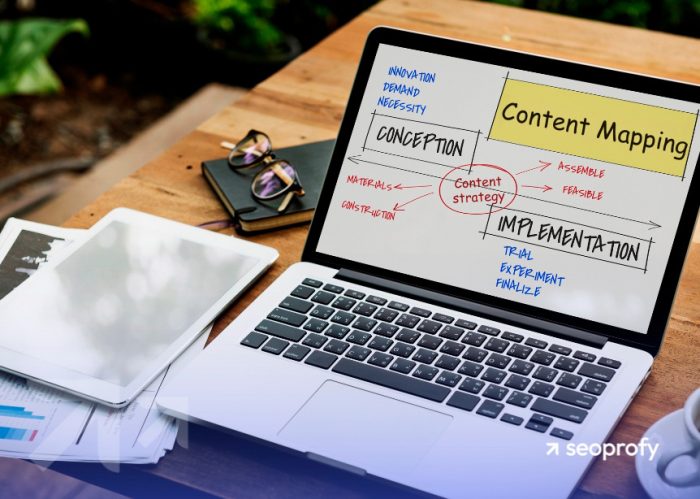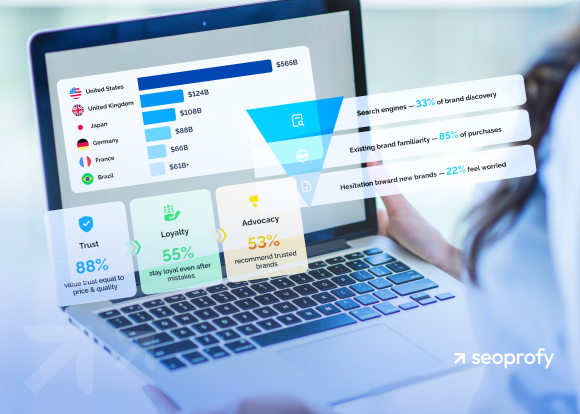Content mapping involves improving the content on your site to make it spot on with the audience at the right time. It requires researching your clients’ behavior at each stage of their customer journey. To ensure the best experience for your audience, you need to create a content map.
High-quality, unique content optimized for your audience’s needs can help you establish your brand’s identity and achieve your business goals. But it’s not enough to just generate tons of unhelpful texts — you need a custom strategy to decide what types of content your audience likes the most. In our guide, you’ll get helpful tips, content mapping examples, and an editable template to streamline your marketing efforts.
- A content map helps you align content with different stages of the customer journey.
- Mapping content is an effective way to organize your workflow, identify the most efficient types of publications, and conduct audience research.
- Creating detailed buyer personas and analyzing the customer lifecycle is essential for proper content mapping.
- Use SEO tools like Search Analytics, Semrush, and Ahrefs to perform keyword research and identify content gaps. Google Docs, Google Sheets, Miro, and Lucidchart can help you bring the plan together.
What Is Content Mapping?
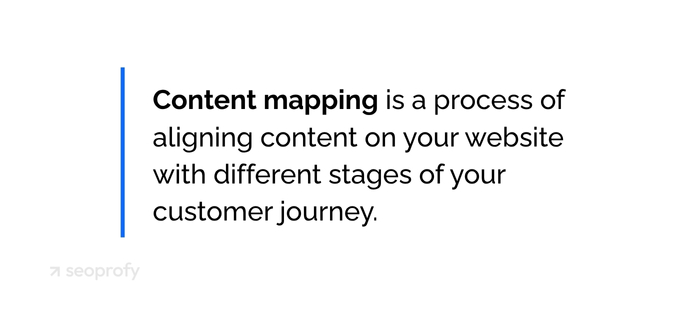
Content mapping is a process of aligning content on your website with different stages of your customer journey. Usually, the buying process includes three important stages, which a person goes through before deciding whether they are ready to buy:
- Awareness
- Consideration
- Decision
Creating content for every stage means that your audience will see the texts, blog posts, or videos covering the topics they are most interested in at a particular moment. It also ensures that your content marketing strategy maintains consistent messaging while having tailored formats for different channels, such as SEO vs. SEM, email marketing, and social media outreach.
The ultimate goal of this process is to create valuable, relevant content that will guide your audience towards making a purchase. The map contributes to your SEO efforts by structuring your website better, matching the right intents, and increasing engagement. Furthermore, content mapping can help you identify new business opportunities and effective ways to engage with your target audience.
What Is a Content Map?
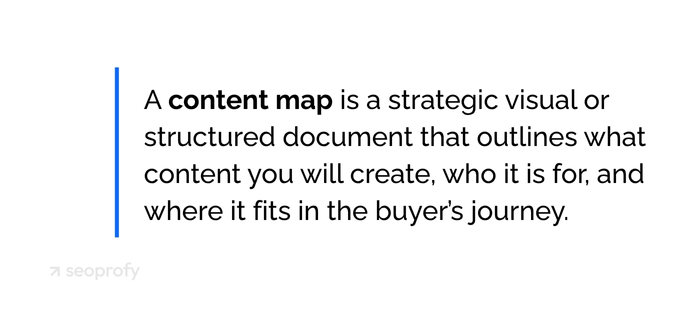
A content map is a plan that shapes the direction of your content marketing efforts, including SEO, data, market research, etc. It considers the particularities of your buyer personas and customer journey stages to meet your audience’s needs with appropriate types of content.
Additionally, a comprehensive plan can help you improve the website’s structure, so you should also consider the content map in UX design. The right categorization and clustering can simplify the search for the desired content and product pages, thereby increasing customer engagement and conversion rates.
What Are the Benefits of Content Mapping?
Whether you’ve just launched a new online project or run your website for a significant period, content mapping has several advantages.
1. Better Customer Understanding
Did you know that 82% of marketers consider understanding their target audience key to content marketing success? Creating a website content map will provide you with in-depth knowledge of your customers’ interests, pain points, and behavioral patterns through a comprehensive analysis. What’s even more important, this data will be sorted according to the prospective customers’ research stage and reflected directly in your strategy.
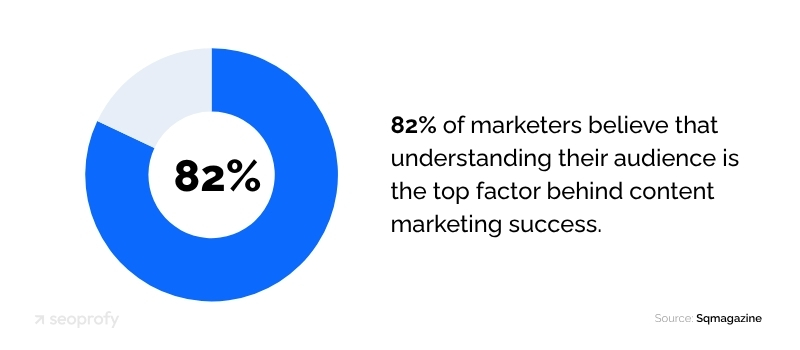
2. Clear Content Development Roadmap
The main reasons content strategies fail are that they are not tied to specific goals and the customer’s journey, as 40% of marketers surveyed by CMI noted. A content map enables you to view your strategy from a new perspective, align it with your objectives, and understand what works for your audience. You’ll have a clear plan defining the right types and amount of content and the publishing schedule that will keep your business growing.
3. Filling Content Gaps
Through mapping content, you’ll identify topics that matter most to your audience and analyze your existing content to see whether it meets all of their needs. Filling in the gaps will help you reach more target customers and boost your credibility. Incorporating these insights into your overall SEO strategy ensures that your content not only meets your customers’ needs but also performs well in search results.
4. Increasing Sales by Attracting Qualified Traffic
A common concern businesses face in digital marketing is getting some traffic but no sales. This issue often stems from the fact that the website attracts visitors who are not yet ready to buy, or the pages they land on contain content that just doesn’t convert. Content mapping eliminates such problems by ensuring that pages reach the right audience at the right moment and fully satisfy their needs.
How to Create a Content Map?
Content mapping involves seven key steps necessary to establish a solid foundation for an efficient marketing strategy. We’ll go through each of them, reviewing the most essential aspects.

Step 1. Define the Goals of Your Content Marketing
Before you create a content map, you need to clearly determine what you want to achieve through this marketing strategy. Your objectives should align with your overall business goals and your audience’s preferences. For instance, you can craft content to:
- Increase brand awareness — your recognition and visibility among your target audience
- Generate leads — encouraging interaction and nurturing potential customers
- Build industry authority — credibility and expertise in a specific niche.
Crucially, you need to monitor your performance on the way toward these goals. This allows you to evaluate the effectiveness of your strategy. Key metrics might include the number of leads, conversion rates, marketing qualified leads (MQLs) and sales qualified leads (SQLs), brand mentions, branded searches, backlinks, and so on.
Step 2. Research and Define Your Target Personas
Before you start working on your map, you need to research your target audience. Who are the people interested in your blog posts or videos? Without conducting a detailed analysis of the potential clients, you simply can’t go further.
Imagine your ideal customers and create buyer personas with detailed descriptions. Consider factors such as demographics, psychological aspects, professional status, pain points and challenges, and the way they approach the buying process.
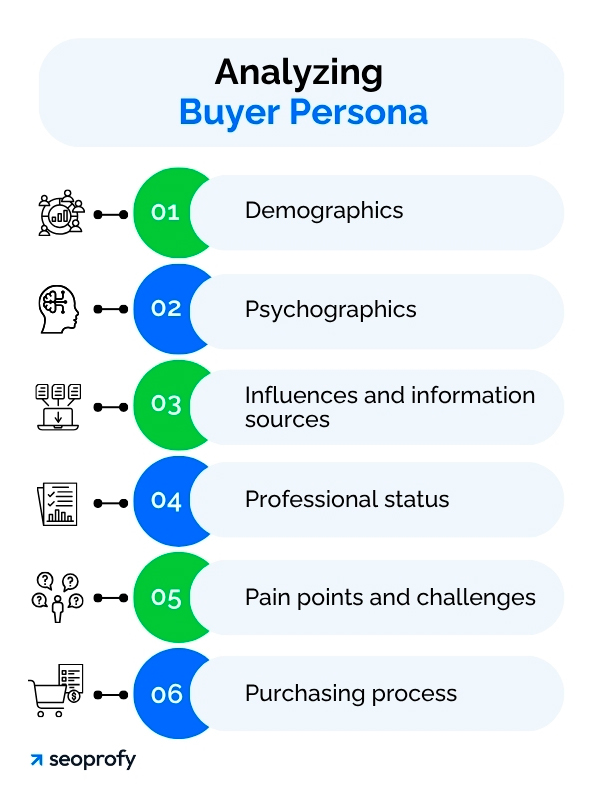
The more comprehensively you analyze your buyer personas, the more information you’ll get for your content map. Ideally, you should gather data using your social media, surveys, market research, and interviews. Here are a couple of questions to ask your audience:
- What are the biggest challenges you face when searching for a product/service?
Knowing your audience’s needs and goals is essential for proper website content mapping, as it can help you create relevant blog posts for every stage of the buyer’s journey and ensure a better customer experience.
- What industry do you operate in?
You can utilize your client’s occupation for content creation. For example, you can create blog posts that showcase real-life examples of how your products or services can help individuals in their particular niches.
- Where do you find information that helps you make a purchasing decision?
The way buyers search for products or services and the sources they turn to can determine various aspects of your strategy, from topic selection to optimization approaches to the choice of marketing channels.
Step 3. Map the Customer Journey Stages
The next step is to review the specific stages of your customers’ buying journey. You need to figure out what your prospective buyers go through between discovering your business and making a purchase. So, while estimating each buying stage, focus on the following:
- Customer’s problems: What are the person’s main challenges and pain points at this stage?
- Search intent: What is the main reason behind the client’s search query? Is their intent informational, commercial, or transactional?
Also, consider the way users search for information about your products and services. Traditionally, they used search engines like Google to find information about the product/service and to navigate to your website. However, leading marketing specialists like Rand Fishkin note that the marketing funnel has started to change, and new trends are influencing the awareness and consideration stages.
For example, zero-click searches through AI have significantly impacted the research process and our interaction with search results and websites. Due to tools like Google’s AI Overviews and ChatGPT, there may actually be no reason for a person to visit your site during the awareness stage.
Additionally, users prefer social media platforms like Instagram for reviewing a company’s products or services, rather than visiting their website. It means that your content creation process should be focused not only on your website but also on other marketing channels.
But what’s never changed is that the decision stage and the buyer’s final steps happen on your website. Thus, all its elements (landing pages, CTAs, etc.) should be perfectly optimized for the best user experience. That is in addition to optimizing your pages to appear in AI Overviews and LLMs and consistently engaging with social media.
Let’s dive deeper into crafting a truly efficient content mapping strategy. Check the table provided below to review the client’s general problems and search intent during each stage:
| Customer Journey Stage | Customer’s Problems | Search Intent | Information Sources |
| Awareness | A person has faced an issue but isn’t sure what to do about it. On this stage, clients usually opt for “how to” questions. | Informational
(low purchase intent) |
Social media, LLMs, forums (e.g., Reddit), search engines |
| Consideration | A customer has identified their problem and is actively seeking a solution. They clarify information about your offers and compare them with competitors. | Commercial
(medium purchase intent) |
Social media, forums, search engines, review platforms |
| Decision | During this stage, your client is almost ready to make a purchase, but they may need to find out more about your products or services (pricing, shipping information, etc.). | Transactional
(high purchase intent) |
Your website, social media, reviews (both on your site and on other platforms) |
Create a similar table for your research process and fill it out with information relevant to your potential clients.
Step 4. Audit Existing Content Against the Journey
Now, it’s time to map your existing blog posts, videos, and pages. Only after a comprehensive analysis of the existing publications will you be able to start working on new SEO content creation.
Use Microsoft Excel, Google Sheets, or Google Docs to create a spreadsheet. Add the links to all types of content and analyze them, filling in the following information:
- Title
- Link
- Content type
- Customer journey stage
- Targeted buyer persona
- Content goal
As a result, you’ll get a content map that looks like this:
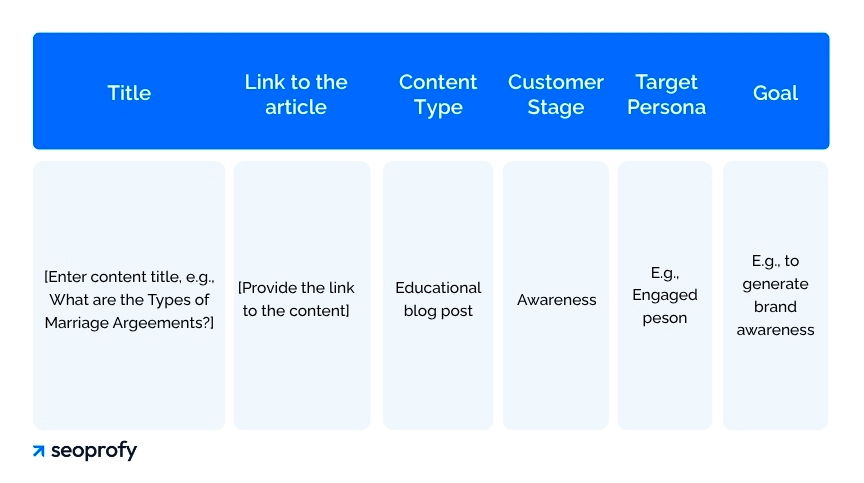
During this step, it’s also essential to check the quality of existing publications. Ensure that your blog posts are well-structured and include up-to-date information, relevant keywords, inspiring CTAs, and other essential elements.
Step 5. Identify Content Gaps and Opportunities
You can use your content map to identify the gaps in your existing publications. There are four main ways to do this: reviewing the customers’ problems, analyzing keywords, researching competitors, and generating ideas with AI.
Your Audience’s Questions
Filter or categorize your content by customer journey stages. Compare it to the list of problems and questions potential clients have at different steps. Does your brand’s content cover all topics that may be of interest to your audience? Add missing topics or questions to your content plan.
Keyword Ideas
One of the key aspects of an effective SEO content strategy is researching keywords related to your business. You can use Semrush to identify queries that haven’t been covered on your website. Create an account, find Keyword Magic Tool, and enter a keyword closely related to your business niche (for example, “buy T-shirts online”):
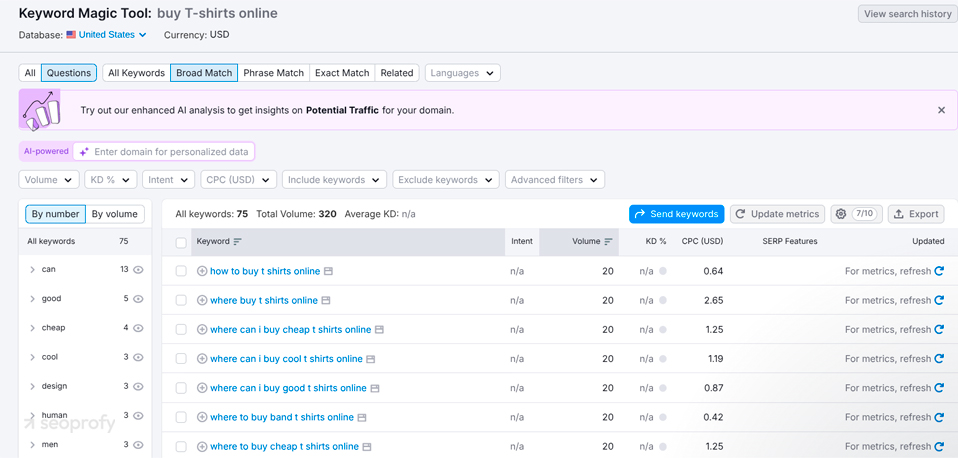
The tool will display a list of various keyword ideas, but if you click on the “Questions” tab, you’ll find related information that your potential customers are searching for. Use search volume filters to sort these questions and check whether your publications provide proper answers to the most popular ones. If you notice something relevant for your audience is not covered, schedule this topic in your content map.
Competitor Analysis
You can discover content gaps by analyzing your competitors’ websites. One way to do this is through Semrush’s Keyword Gap:
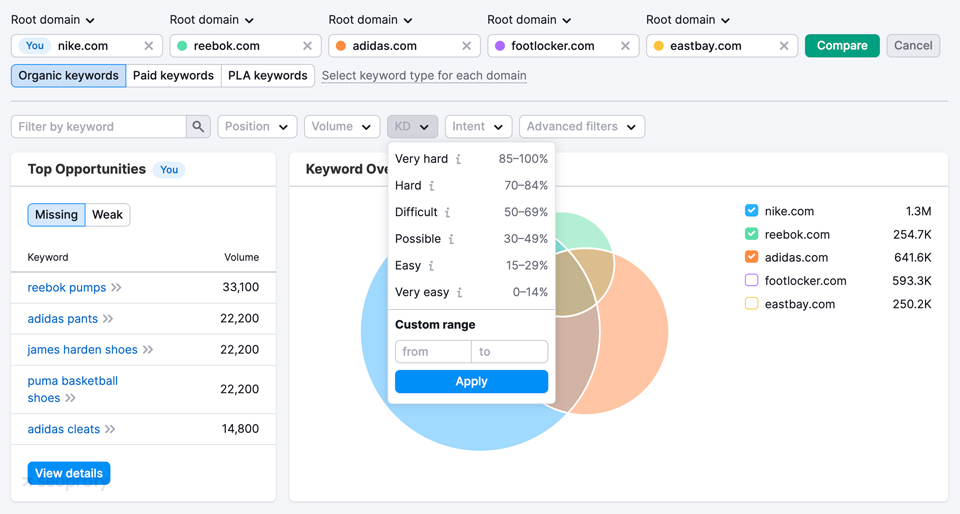
Alternatively, you can use Ahrefs. Go to Competitive Analysis, enter your domain and your competitors, and click “Show keyword opportunities”:
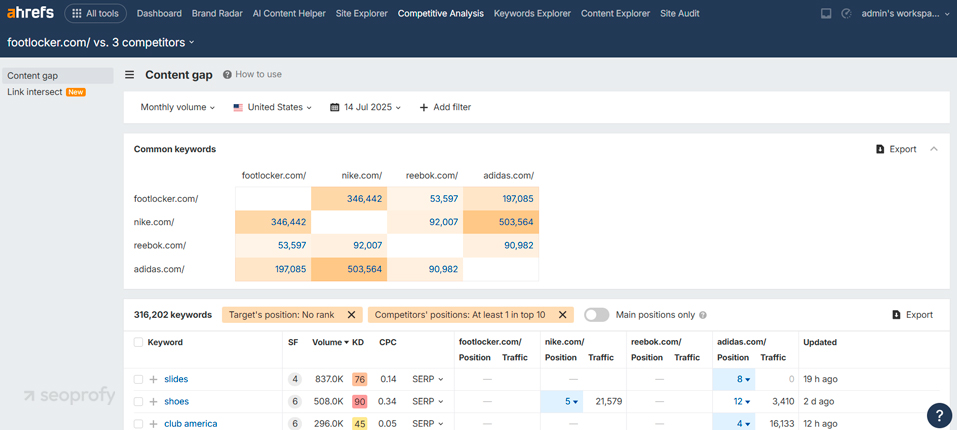
AI Suggestions
More than 86% of SEO professionals are using AI in their strategy, and researching content ideas is one of the most common applications of this technology in marketing. Tools like ChatGPT, Claude, and Gemini, or specialized AI solutions for marketing (such as Jasper) can suggest topics or questions that you can explore. However, be careful with using AI for content creation — it requires a careful approach to avoid unpleasant surprises.
Step 6. Assign Content Types to Each Stage
If you want your content mapping process to bring you the best possible results, you need to understand how this or that content type works and when you should use it. The table provided below includes general recommendations that you can use to meet your customers’ goals at certain stages of their journey.
| Customer Journey Stage | Content Goal | Preferred Type of Content |
| Awareness | Provide useful information about the industry-related topics, engage with prospective clients, and introduce your brand. |
|
| Consideration | Persuade a potential buyer that you offer the best solution to their problem. |
|
| Decision | Encourage a person to finally make a purchase. |
|
Putting it into practice, let’s imagine you want to improve the business process of your online store by implementing an advanced CRM system. Eventually, you may want to discover more about this topic by googling: “What is CRM (Customer Relationship Management)?”
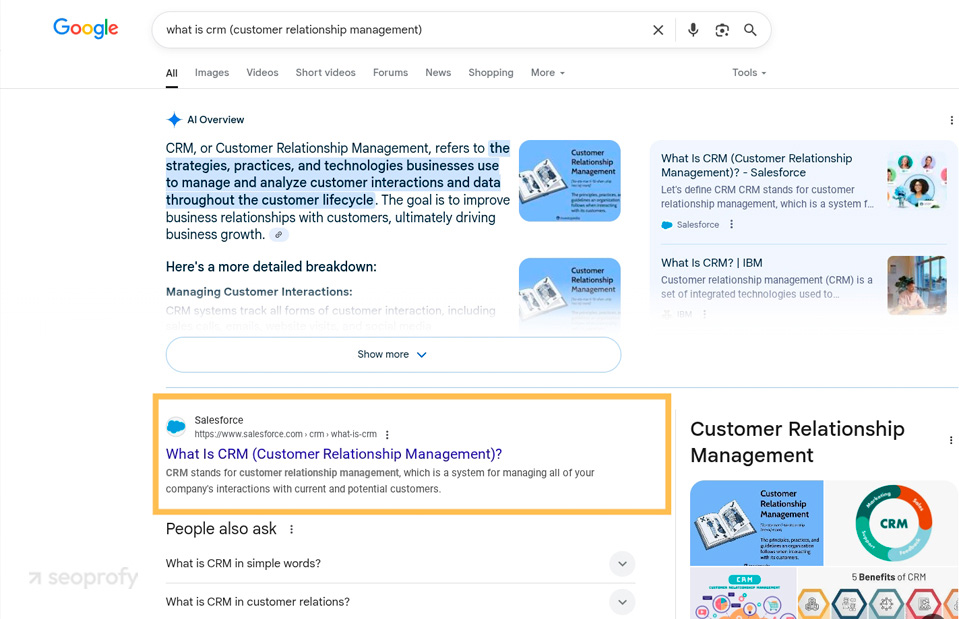
Following the AI Overviews, you can find a blog post by Salesforce that provides additional information on this topic. This article was created to meet the informational intent of the potential buyer on the awareness and consideration stage. Salesforce uses this opportunity to present its own CRM:
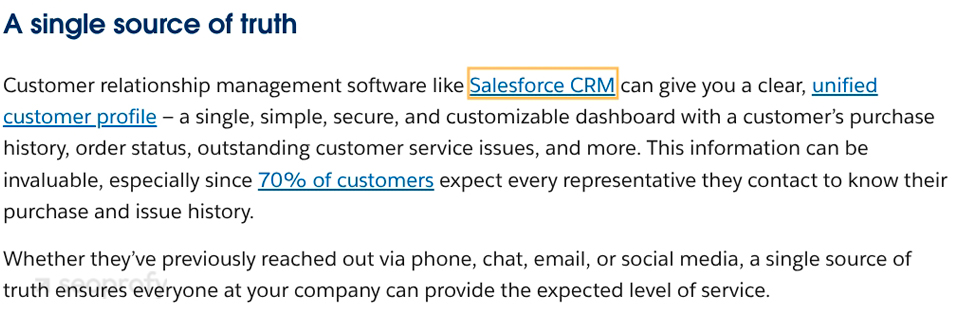
Although it’s an informational blog post, the inclusion of an internal link allows the reader to be guided to a landing page, where they are encouraged to choose this product with more promotional information and testimonials:
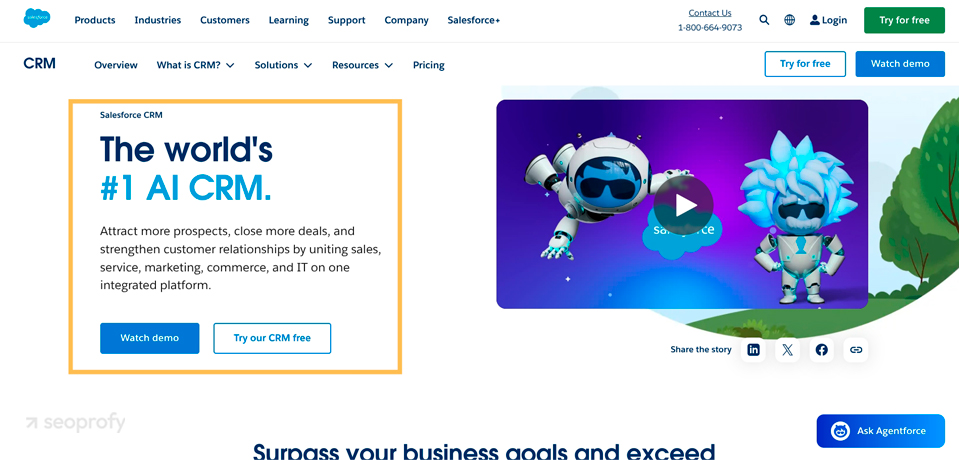
Tailored to a commercial and transactional intent, the page includes CTAs that motivate the visitor to check the product, ask questions, or sign up for newsletters. As you can see, the company offers several ways for further interaction and smooth lead nurturing.
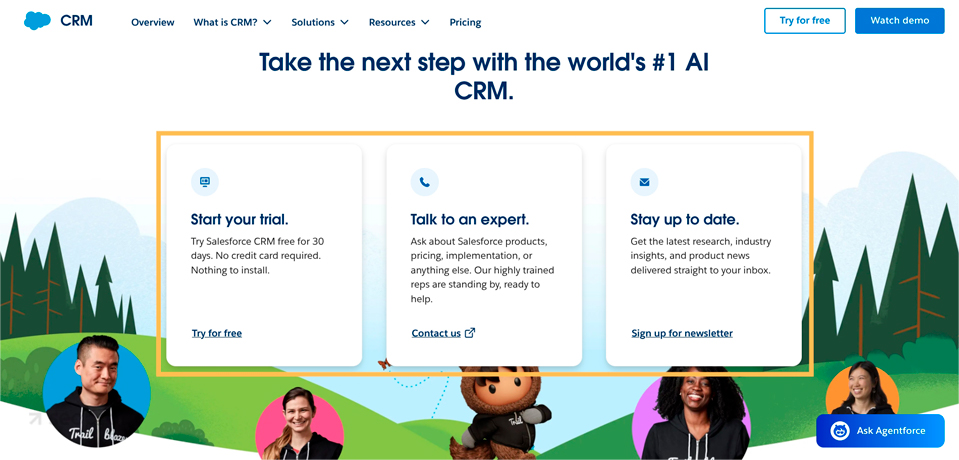
This shows how a proper combination of various content types and strategic placement of links between them can ensure a smooth customer journey.
Step 7. Create a Plan and Start Implementing It
Using all the data received from analyzing your customers, existing publications, and content ideas, you can build a content map focused on improving customer engagement. Use the examples provided above or download our content mapping template to speed up the process. To prioritize your topics and review your overall strategy, answer the following questions:
- Is there enough personalized content for all three stages of the buying journey?
- Are all our buyer personas equally well-served?
- Which types of content should we prioritize, considering potential conversion rate and production costs?
It’ll be a good idea to combine your content map with a digital calendar. Thus, you’ll create a perfect marketing plan, ideal for your content team coordination and brainstorming new ideas. So, let’s put all your knowledge into practice and create a content map for a website to increase organic traffic and boost your revenue.
Content Map Example & Editable Template
We’ve created a free content map template that you can edit according to your needs and business specifics. Download our example now and use it to:
- Create content for each customer stage and buyer persona
- Organize workflow and publication schedule
- Streamline your content creation efforts
- Increase the effectiveness of your publications
Get a Free Content Map Template
Best Tools for Content Mapping
There aren’t many dedicated content mapping tools, but SeoProfy’s content team recommends using these services to streamline the process:
- Google Docs & Sheets: This is the simplest solution. You can use Google Docs or Google Sheets to create your own content map (or edit our template), store your publications, and interact with your team right in the documents.
- Lucidchart or Miro: This software is ideal if you want to create a more appealing visual representation of your strategy.
- Search Analytics, Semrush & Ahrefs: These are some of the most effective SEO tools for keyword research and generating content ideas.
Tips to Keep Your Content Map Effective
Once you create an efficient content map, you need to properly manage it and keep everything up to date. Here are a couple of tips that will help you deal with this task:
- Review your strategy regularly: Check your content map regularly to ensure it remains aligned with your current business goals and user behavior.
- Listen to your audience: Monitor and incorporate feedback from your team and audience to ensure you haven’t missed anything and that your content is aligned with the buyer’s journey stages properly.
- Repurpose content: A detailed research can be presented not only in a blog post but also in social media publications with captivating visuals, email newsletters with summaries of main points, or guest posts on other platforms (as a chance to get backlinks and increase brand awareness). This is content repurposing, and it can maximize your reach and impact while using your budget efficiently.
Conclusion
A content map is an efficient tool for organizing your entire content marketing campaign. It allows you to keep all your publications and ideas in one place and use them properly to get the maximum results.
Do you want to capture the attention of your audience on every step of their journey, increasing your conversion rates and sales? Our SEO agency is ready to lend you a helping hand! Focus on more important business tasks while we apply digital marketing expertise to do thorough research, comprehensive planning, and high-quality content creation for the growth of your company.

